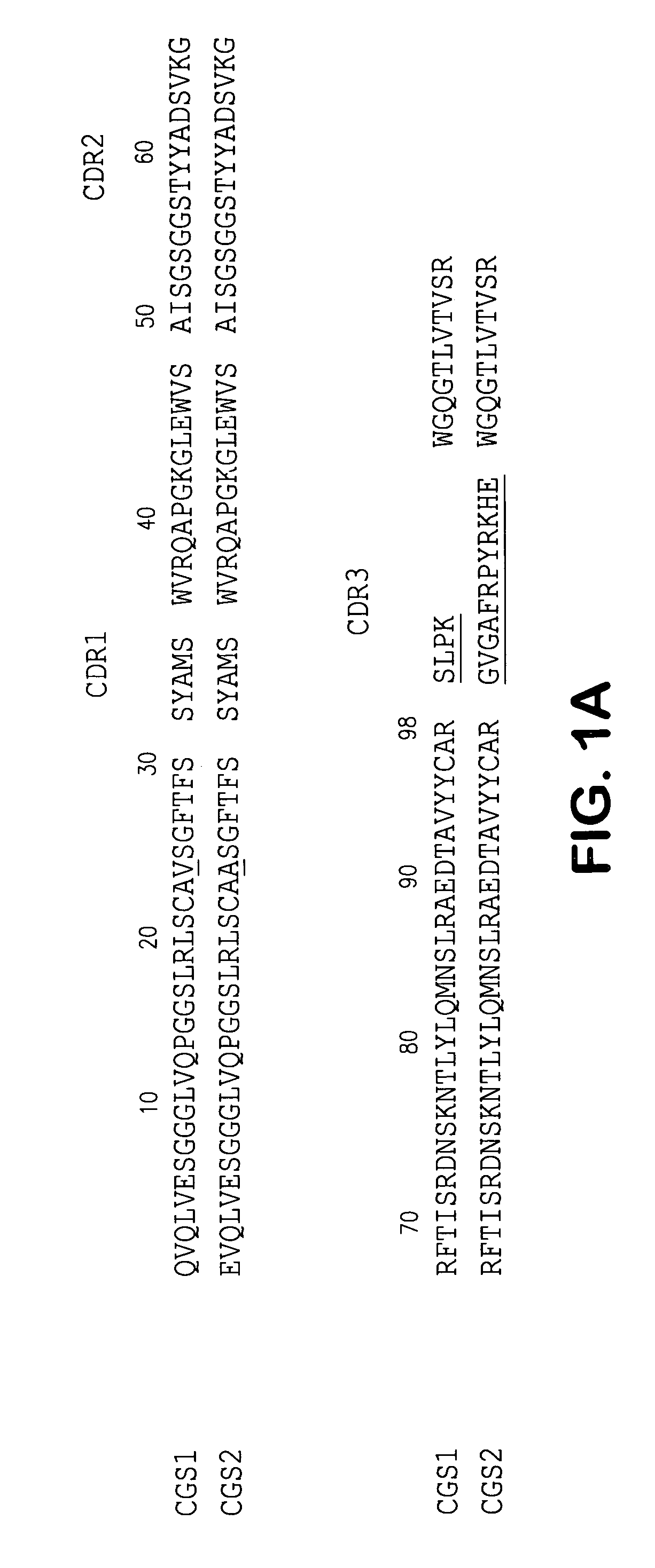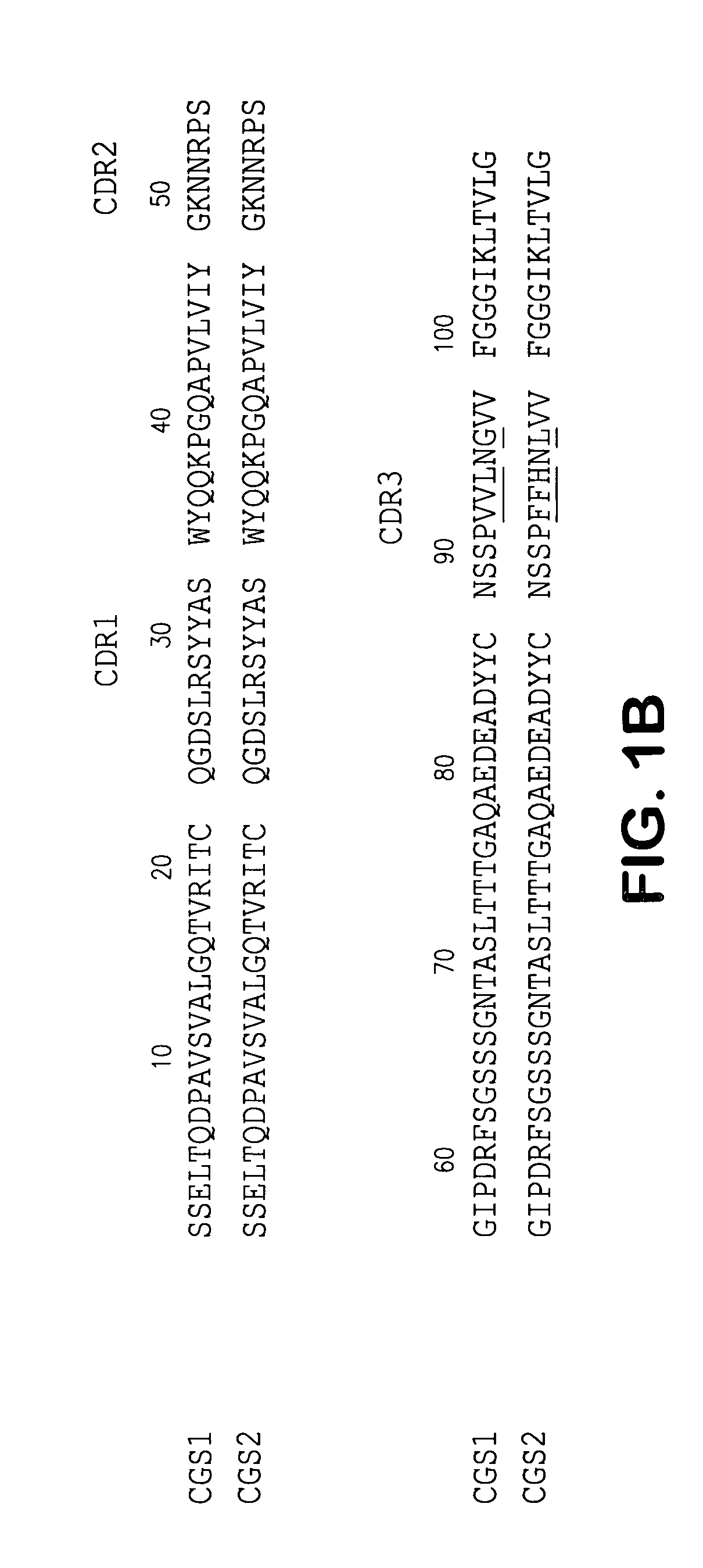Antibodies to the ED-B domain of fibronectin, their construction and uses
a technology of fibronectin and edb domain, applied in the direction of immunoglobulins, peptides, drugs/humans, etc., can solve the problems of limited success experience of chemotherapy and radiotherapy, lack of specificity of treatment, toxic side effects on normal tissues,
- Summary
- Abstract
- Description
- Claims
- Application Information
AI Technical Summary
Benefits of technology
Problems solved by technology
Method used
Image
Examples
example 1
Isolation of Human scFvs Specific for the ED—B Domain of Human FN
[0089]A human scFv phage library (Nissin et al, 1994) was used for the selection of recombinant antibodies. Two different forms of the ED—B isoform were used as source of antigen for selection and in both cases, the isoform was recombinant human protein.
[0090]Recombinant FN peptides containing the type III repeats 2-11 (B−) and 2-11 (B+) were expressed in Esherichia coli.
[0091]A construct was made using FN cDNA from the clones pFH154 (Kornblihtt et al 1985), λF10 and λF2 (Carnemolla et al, 1989). The cDNA constructs, spanning bases 2229-4787, (Kornblihtt et al, 1985) were inserted into the vector pQE-3 / 5 using the QIAexpress kit from Qiagen (Chatsworth, Calif.). The recombinants FN-III 2-11 (B−) and (B+) were purified by immunoaffinity chromatography using the mAb 3E3 (Pierschbacher et al 1981) conjugated to Sepharose 4B (Pharmacia). DNA fragments for the preparation of the recombinant FN fragments containing the type...
example 3
Specificity of Affinity Matured scFvs for ED—B-Containing Fibronectins
[0103]The immunoreactivity of the two affinity matured scFvs, CGS-1 and CGS-2, was assessed initially by ELISA and compared directly to the mAb BC-1 (which recognizes the B—FN isoform) and mAb IST-6, which only recognizes FN isoforms lacking ED—B (Carnemolla et al., 1989; 1992). The characterization of these mAbs has been previously reported (Carnemolla et al, 1989; 1992). Fine specificity analysis was thereafter carried out using an extensive panel of FN fragments derived by thermolysin treatment and of recombinant fusion proteins.
[0104]The antigens used for ELISA and immunoblotting were prepared as follows. FN was purified from human plasma and from the conditioned medium of the WI38VA13 cell line as previously reported (Zardi et al, 1987). Purified FNs were digested with thermolysin (protease type X; Sigma Chemical Co.) as reported by Carnemolla et al (1989). Native FN 110 kD (B−) and native FN 120 kD (B+) frag...
example 4
The Use of Affinity Matured Anti-ED—B scFvs in Immunocytochemical Staining of Human and Mouse Tumors
[0114]CGS-1 and CGS-2 have both been used to immunolocalize ED—B containing FN molecules in various normal and neoplastic human tissues. For normal tissue, skin was chosen, since the B—FN isoform is known to be expressed in macrophages and fibroblasts during cutaneous wound healing (Carnemolla et al, 1989; Brown et al, 1993). The two human tumors selected have previously been analyzed for the specificity of staining with anti-fibronectin mAbs: glioblastoma multiform has been studied in detail because endothelial cells in the vessels of this tumor are in a highly proliferative state with increased angiogenetic processes including the expression of B—FN isoforms (Castellani et al, 1994). Furthermore, studies using a diverse panel of normal, hyperplastic and neoplastic human breast tissues have provided further evidence of a correlation between angiogenesis and B—FN expression (Kaczmarek...
PUM
| Property | Measurement | Unit |
|---|---|---|
| Current | aaaaa | aaaaa |
| Digital information | aaaaa | aaaaa |
| Dissociation constant | aaaaa | aaaaa |
Abstract
Description
Claims
Application Information
 Login to View More
Login to View More - R&D
- Intellectual Property
- Life Sciences
- Materials
- Tech Scout
- Unparalleled Data Quality
- Higher Quality Content
- 60% Fewer Hallucinations
Browse by: Latest US Patents, China's latest patents, Technical Efficacy Thesaurus, Application Domain, Technology Topic, Popular Technical Reports.
© 2025 PatSnap. All rights reserved.Legal|Privacy policy|Modern Slavery Act Transparency Statement|Sitemap|About US| Contact US: help@patsnap.com



